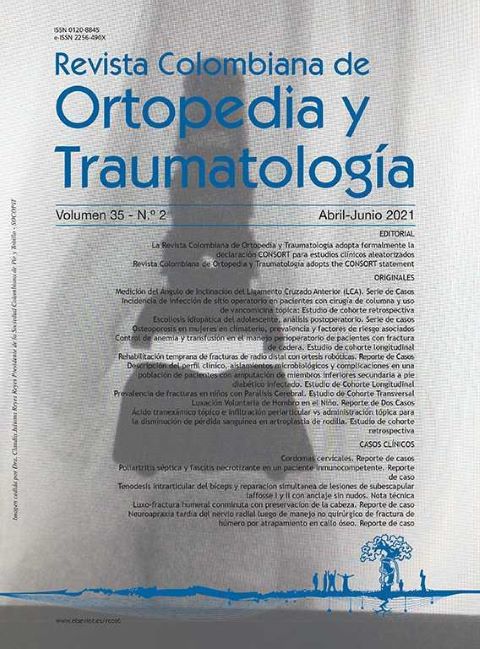Voluntary Shoulder Dislocation in Children. Case Report
DOI:
https://doi.org/10.1016/j.rccot.2021.02.009Keywords:
Shoulder, voluntary dislocation, shoulderAbstract
Background: Voluntary dislocation of the glenohumeral joint represents the ability to spontaneously dislocate a shoulder in one or more directions. The theoretical cause is the ability to contract agonist muscle groups, and inhibiting or relaxing antagonistic muscles, thus determining the direction of the dislocation. The diagnosis is usually made in childhood or adolescence when the patient demonstrates a voluntary shoulder dislocation. Historically, this condition has been linked to psychological disorders or illness and typically responds poorly to surgical interventions. Treatment typically consists of conservative management including cognitive behavioral therapy or physical therapy. Prior prospective studies have demonstrated no advantage to surgical interventions over nonoperative treatments, and in some cases with associated increased morbidity.Case Report: Being a rare condition, two cases of voluntary shoulder dislocation are reported. The first patient is a boy, 12-year-old with 2 years of voluntary bilateral posterior shoulder dislocations, with 17-year follow-up, the patient did well. The second case is an 8-year-old girl with voluntary posterior dislocation of the right shoulder who after three year follow up responded well to conservative treatment.
Discussion: The risk of developing osteoarthritic changes or the appearance of chondral lesions are major long-term concerns with this disease. Currently there is no specific treatment consensus and little evidence regarding the prognosis of this condition. Voluntary shoulder dislocation is a rare entity of unknown etiology. Patients report no history of trauma but is often associated with psychiatric conditions. Prospective studies have reported favorable results of nonoperative treatment during childhood. Evidence Level: IV
Downloads
References
Leftort G, Pfliger F, Mal-Lawane M, Belouadah M, Daoud S. Capsular shift for voluntary dislocation of the shoulder: results in children. Rev Chir Orthop Reparatrice Appar Mot. 2004;90:607-12. https://doi.org/10.1016/S0035-1040(04)70720-5
Rowe CR, Pierce DS, Clark JG. Journal of Bone and Joint Surgery. 1973;55A:445. https://doi.org/10.2106/00004623-197355030-00001
Dislocation Of The Shoulder. The British Medical Journal 1973 December 1;4(5891):505. https://doi.org/10.1136/bmj.4.5891.505
Anterior Dislocation of the Shoulder in a 10-Year-Old Child Treated Surgically. J Hand Microsurg 2011; 11(4):A23.
Shigehito Kuroda MD, Tetsuyuki Sumiyoshi MD, Johji Moriishi MD, Kimiko Maruta MD, Noriyuki Ishige MD. The natural course of atraumatic shoulder instability. Chiba, Japan, Journal of Shoulder and Elbow Surgery Board of Trustees. 2001. https://doi.org/10.1067/mse.2001.111962
Matthew D, Milewski MD, Carl W, Nissen MD. Pediatric and Adolescent Shoulder Instability. Clin Sports Med. 2013 Oct;32:761-79. https://doi.org/10.1016/j.csm.2013.07.010
Heller KD, Forst J, Cohen B, Forst R. Atraumatic recurrent posterior shoulder subluxation: Review of the literarure and recomendatios for treatment. Acta Orthopaedica Belgica. 1995;61:263-70.
Huber H. Voluntary subluxation of the shoulder in children. J Bone Joint Surg (Br). 1994;76:118-22. https://doi.org/10.1302/0301-620X.76B1.8300653
Giovanni Merolla. Elisa De Santis. Functional outcome and quality of life after rehabilitation for voluntary posterior shoulder dislocation: a prospective blinded cohort study. Eur J Orthop Surg Traumatol. 2015;25:263-72. https://doi.org/10.1007/s00590-014-1486-0
Pesach Shvartzman MD, Nir Guy MD. Voluntary dislocation of shoulder. POSTGRADUATE MEDICINE. 1988;84:265-6, https://doi.org/10.1080/00325481.1988.11700449, 271.
Raymond Michael Greiwe MD, * Greg Galano MD, w Jeff Grantham BSz, Christopher S. Ahmad, MDz. Arthroscopic Stabilization for Voluntary Shoulder Instability. J Pediatr Orthop. 2012;32:781-6. https://doi.org/10.1097/BPO.0b013e31826b6ee1
Melih Malkoc, Ozgur Korkmaz, Ali Seker, Ismail Oltulu, Guray Batmaz, Mahir, Mahirogulları. Voluntary Glenohumeral Joint Luxation In Children: Two Cases. Orthopaedic Journal of Sports Medicine. 2014;2:11. https://doi.org/10.1177/2325967114S00266
Andrew G, Pollen. Successful surgical treatment of bilateral recurrent dislocation of the shoulder. Journal of the Royal Society of Medicine. 1984;77:331-3. https://doi.org/10.1177/014107688407700416





